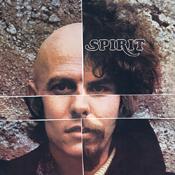Spirit's Debut Is a "Stairway To Heaven"
Spirit’s 1971 release The 12 Dreams of Doctor Sardonicus (Epic E30267) may be the best Spirit album, and one of the finest albums of the psychedelic and post-psychedelic era, but this, the band’s debut, recorded in 1967, falls not far behind and holds up remarkably well for many reasons.
If you’re unfamiliar with Spirit and have the good sense to pick up this reissue, when you get to Randy California’s “Taurus,” you’ll exclaim “They ripped off ‘Stairway to Heaven!’” except of course, “Taurus” came years before!
Not that the boys (and especially Jay Ferguson) hadn’t been listening and borrowing themselves. Yet while there’s Fresh Cream spilled all over Ferguson’s “Uncle Jack,” and other obvious influences pop up throughout the set, Spirit claimed its own unique musical territory, melding jazz, salsa, psychedelia, raga-rock and rock into an atmospheric blend that honestly captures the mood of the time without excess.
The back cover photo reveals much about the band and the period. There’s scruffy-looking guitarist Randy California center stage adorned with beads and an Indian blanket. To his left, looking like a refuge from The Association is a serious-looking, well coiffed, knit turtle necked Jay Ferguson, who contributed much of the material. Across from him, bassist Mark Andes (the two would later form Jo Jo Gunne and I would cut the national radio spot for their debut release on Atlantic). Behind him keyboardist John Locke, and in the background, bald-headed drummer Cassidy, who back then, to this 20 year old, looked really old and today just looks just plain bald and mildly approaching middle-age.
These guys could swing in odd meters, propelled by Cassidy’s muscular drumming, Locke’s McCoy Tyner influenced electric piano block chording and especially California’s fluid overdriven, double tracked electric guitar. Had Spirit been a “jazz-rock” group, this record wouldn’t have dated well. Instead, Spirit was a rock band that would abruptly shift gears and break out in breezy jazz, and then it would downshift back to 4/4 rock, scattering Airplane, Love, Moody Blues and Doors references as it tooled along on its own unique path.
Producer Lou Adler (whose Ode label distributed by CBS originally released this album), clearly believed in the band, hiring jazz arranger Marty Paich to create the horn and string charts that dot but don’t drench the record. Paich’s contributions cannot be overstated as his charts were models of understatement that never smothered the group’s rock intentions. Listen to the strings on “Topanga Windows,” which is reminiscent of Donovan’s “Mellow Yellow,” which came out around the same time. Which came first? I don’t know.
Side one offers still impressive musical chops, moody, cinematic atmospherics, sonic drama, and track-by-track uniqueness, originality and creativity that compares favorably with any record released during this incredibly fertile time period.
Side two loses a bit of steam, though it’s still a strong side, with the aforementioned “Topanga Canyon,” and the dramatic “The Great Canyon Fire,” but the promise of the wistful “Gramophone Man” dissipates as the group breaks into its “jazz overdrive” mode one time too often. The folky ditty “Water Woman,” is pleasant filler followed by the compelling “The Great Canyon Fire” (though it too mixes effective drama with the “jazz break,” one time too often).
The side noodles out with Locke’s overly ambitious, Zappa meets The Doors’ “The End,” meets John Coltrane epic “Elijah,” but epics (and drum solos) were encouraged back then, and despite its failure, “Elijah” still makes for an interesting listen.
Jay Ferguson gets full or partial writing credit on every track save two, and his contribution to the success of this record cannot be overstated. He obviously had a big record collection and he wasn’t afraid to play it and troll for ideas, but he didn’t borrow as much as he was inspired.
Bob Irwin’s mastering remains remarkably faithful to the tonal balance and feel of the original, though I only have an original stereo copy. There’s a strong case to be made for the superiority of the mono mix. This sounds like an original 4 track recording, with, on most tracks, drums mixed to one track and panned hard left, keyboards hard right and vocals centered (on the “stereo” mix, of course). There are arbitrary choices made in the mix track-by-track, which gives the stereo mix a lack of coherence and purpose.
Thus this is not really a “stereo” recording and the hard left, center right divisions tend to pull the mix apart. The only advantage of the stereo mix is the separation of Randy California’s doubled guitar lines. Otherwise, the mono mix, is more coherent, more powerful, more consistent and more “together.”
Because these guys can play, they are given the space to assert themselves individually, which is a plus, but they sound better mixed down to mono on what is a competent but not great recording and production.
Spirit’s debut is an ambitious, partially fulfilled debut, which sounds like a great band struggling to break free of the production constraints. And while it made a great record here, it could have made a stupendous one had it been handled somewhat differently. Two engineers are credited: Erik Wangberg, who I have never heard of and Armin Steiner, who had and continues to have a distinguished career as an engineer and mixer. His recent credits include recording and mixing the orchestral recordings for “Finding Nemo,” “Seabiscuit” and many other films. Judging but what I’m hearing here, Steiner recorded Paich’s strings and horn arrangements because they sound best.
In any case, this is a terrific reissue for those familiar with it, and especially for those who are not. United’s pressing, at least my copy, was only good as there was occasional noise and a visual inspection showed some odd patterns in the vinyl indicating that the press was not operating at 100% efficiency. Don’t let that stop you though.
- Log in or register to post comments



